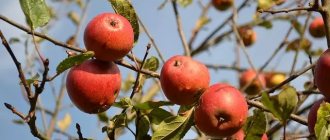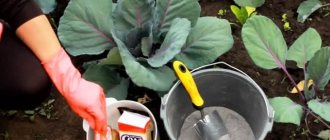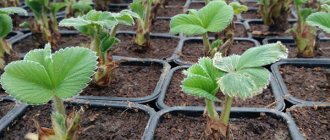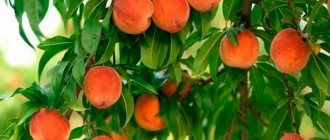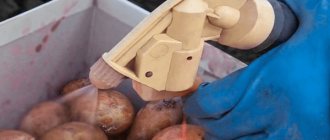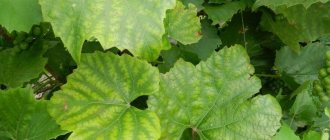Apple trees are loved by most summer residents for their excellent healthy fruits and ease of care. However, these plants have many natural enemies from which they must be protected. Today we will talk about how and with what to treat apple trees in early spring from pests and diseases in order to protect the tree as much as possible, reduce labor costs during the “hot” summer season and get a decent harvest.
Apple trees need preventive treatments during different periods of the growing season.
Indications for apple tree processing
The apple tree should be treated preventively in accordance with the gardener’s calendar. In the spring, up to 15 procedures are carried out against diseases and pests. If symptoms of a specific disease or pest appear on the tree, treatment should be carried out immediately.
The concentration of drugs and the frequency of treatments depends on the climate zone. In the southern regions, where there is greater biological activity, trees need to be treated more often and stronger solutions must be made.
Pests and pathogens of various origins adapt to certain drugs. Therefore, from processing to processing they should be changed to others.
Treatment of apple trees for scab is carried out as necessary with mandatory repetition.
The apple tree should be treated for prevention
When fighting a particular pest, you should study the symptoms of its appearance and food preferences. strengths and weaknesses, resistance to certain agents.
Folk remedies
If the fruit trees in the garden are not very actively affected by pests, you can try to protect the crop using infusions of wild herbs, garden plants and some products that are widely used in everyday life. We list some of them in the table:
| Pest | Means of protection |
| Apple blossom beetle | Infusion of mustard powder, solution of laundry soap, infusion of wood ash or chamomile |
| Aphids | A decoction of onion peels, an infusion or dry shag powder, an infusion of greens and dandelion roots, an infusion of wood ash, a decoction of citrus peels, a powder of dried garlic or dried marigolds |
| Ticks | Infusion of greens and dandelion roots, decoction of onion peels |
| Medyanitsa | Infusion or dry powder of shag, infusion of herbs and dandelion roots |
| Butterflies and their caterpillars | Infusion of potato or tomato tops, decoction of wormwood, infusion or dry powder of shag, infusion of wood ash or burdock leaves |
| Sawfly larvae | Decoction of wormwood, infusion of potato or tomato tops |
| codling moth | Infusion of tomato tops, decoction of tansy or wormwood, tar or tar soap (the product is soaked in pieces of fabric that are hung on a tree), food-grade “liquid smoke” |
Various aromatic herbs have an insecticidal effect, but do not destroy, but temporarily repel pests
Folk pest control remedies are, in general, less effective than commercial chemicals. They are not suitable for protecting heavily damaged plants. In addition, the gardener does not always have the opportunity to use infusions and decoctions of herbs, since in the early stages of preventive work there are still no fresh raw materials, and dry preparations made last fall by this time have largely lost their insecticidal properties. Spraying with “natural” preparations is often done at the end of spring, replacing repeated treatments with more aggressive “chemistry”.
Stages and rules of treatment for diseases
The stages and rules of processing for different climatic zones are similar; they are tied to the stages of the annual cycle of the plant.
Spring preventive treatment of apple trees is divided into three stages:
The air temperature during the day becomes positive, but the tree has not yet emerged from hibernation. Spring pruning is carried out, removing old bark along with overwintered pests. Next, the apple tree is sprayed with fungicides; at this stage, the maximum dosage of the active substance can be given. The stage is completed by whitewashing with lime with the addition of copper sulfate or paint for garden trees. In the middle zone, the stage occurs in mid-March.
- Swelling of the kidneys. The main threat at this time is the flower beetle. Broad-spectrum contact insecticides are used against it. The concentration should be moderate, otherwise you can burn your kidneys.
- The third stage is carried out after flowering. Insecticides specialized against leaf eaters are used. It is unacceptable to miss it. otherwise, you can lose most of the foliage and slow down fruit growth.
Gardening specialists have formulated a number of rules for processing:
- It is necessary to spray in clear weather at temperatures above +5°C;
- the sprayer must be in good working order and create a uniform, concentrated cloud of fine suspension;
- after flowering, you cannot use chemicals; pests will have to be collected or shaken off manually;
- the use of fungicides is permissible before the fruit begins to ripen.
To get a good harvest, you have to work hard. It is important to meet deadlines. sequence and processing rules.
Understanding technology
To treat the garden you will need: a special liquid (fungicide dissolved in water), a pump (treatment device) and protective equipment (gloves, mask, goggles).
The easiest way to spray columnar apple trees is to just walk around the plant and spray the fungicide over the entire surface. There is no need to climb stairs or twist in order to get to an inconveniently growing branch...
Spraying young apple trees is a little more complicated - it is important to spray the solution over the entire surface of the plant, starting from the trunk and ending with the top, without missing a single branch. Be careful with young animals: a concentrated solution can cause chemical burns to thin bark and fragile shoots. Therefore, before you start spraying apple trees throughout the garden, conduct a small experiment:
- select a victim of experience (any of the plants);
- apply the mixture to one of the branches;
- wait 2-3 days.
If the branch remains healthy, feel free to spray your liquid throughout the garden. By the way, choose a young plant for the experiment. If an old apple tree becomes a victim of the experiment, you will get one of two possible results: the damaged branch will not be able to recover (due to age); chemistry will not be able to do much harm to the “thick-skinned” plant (but then it will eat all the young ones that it gets on in a couple of days).
Spraying apple trees against pests and diseases, whitewashing trees, installing traps and other measures to combat the health of the garden are successfully carried out by our experienced gardeners. Many years of experience, the availability of specialized tools and skillful hands allow us to quickly and efficiently create ideal conditions for the development of your garden.
Preparations for spraying apple trees
| Means | Against what | Application method and dosage | Duration of protection. days | Waiting period, days | Application |
| Potent insectofungicides | |||||
| DNOC | universal | 50g/10l | 20-30 | — | Once every 2-3 years, before buds appear or after shedding leaves |
| Nitrafen | 200g/10l | 1-2 times a year, before buds appear or after shedding leaves | |||
| Copper sulfate | 300g/10l | ||||
| Bordeaux liquid | |||||
| Urea (urea) | 60g/l | ||||
| Ammonium nitrate | |||||
| Fungicides | |||||
| Fitosporin | Fungus | 5g/10 l | 10-14 | 0 | Unlimited |
| Insecticides | |||||
| Confidor | Sucking and gnawing insects | 1g/10l | 15-20 | 1-2 | |
| Calypso | Leaf rollers, flower beetles, codling moths, scale insects | 2ml/10 l | 2 | ||
| Inta-Vir | Ants | 100 g per 500 m 2 | 7-12 | — | N/A |
| Protective means | |||||
| Var, ready-made compounds | Protection of cuts and wounds | — | — | After trimming | |
| Lime | Protecting the bark from burns and insects | Until sour cream | Spring and autumn | ||
| Antibiotics | |||||
| Ampicillin | microorganisms | 1 amp/10l | N/A | N/A | Of necessity |
| Fitolavin | 20ml/10l | 50 | No more than 14 days | ||
| Ofloxacin | 2 tablets/10l | Before and after flowering | |||
| Phytohormones | |||||
| Epin | viruses | 2amp/10l | — | — | Before flowering, after collecting pods. |
| Zircon | 40 drops/l | — | — | No more than 14 days | |
| Folk remedies | |||||
| Salt | Scab, insects | 1 kg/10l | 20 | — | Before the start of the growing season |
| Diesel fuel | Bark beetles and other insects | — | before the buds appear | ||
| Tar soap | Aphid | 60g/10l | — | Once after flowering | |
When to process an apple tree according to the lunar calendar: favorable days by region
It is worth noting that when choosing a processing period according to the lunar calendar, it is best to select the decreasing phase. This year we need to focus on the following dates:
- in May – from 28 to 31;
- in June – 1, from 3 to 8, from 26 to 30;
- in July – 1, from 3 to 8, 26-30.
As for the characteristics of the regions, they are based on weather conditions and air temperature. You should not spray apple trees if frost is predicted for the night. You also need to take into account the recommended temperature in the instructions for use of the products.
Means and methods for treating apple trees against diseases
For various diseases and pests. affecting fruit crops, appropriate methods of prevention and treatment have been developed.
Treatment of moniliosis
This common tree disease is caused by spores of a harmful fungus carried by bees and other insects that pollinate the inflorescences. Branches and foliage look scorched. Diseased elements of the tree are removed and burned. The tree and its neighbors are sprayed with potent antifungal compounds, such as:
- Horus;
- Topsin;
- Abiga Peak.
To reduce the risk of disease, it is better to carry out preventive treatment of the garden in three stages:
- before flowering;
- after flowering;
- 14 days after the second stage.
Fungus treatment
If untreated cuts or broken branches are left on the apple tree, mold may penetrate them. Hollows may form at the site of the lesion.
Treating apple trees against fungus
Damaged areas are cleaned until a healthy layer of wood appears. They are treated with 2% copper sulfate.
The treated areas are covered with garden varnish or a special composition.
Fighting fruit rot
If moniliosis cannot be controlled by treating apple trees in the spring, the disease affects the fruits. The disease is called gray or fruit rot.
All rotten and darkened fruits should be collected and burned. The tree is treated with a potent fungicide. It is important to complete the processing 30-35 days before the planned harvest date. If there is less time left. I will have to limit myself to the biological product Fitosporin. It is applied twice with an interval of 14 days.
It is important to distinguish gray rot from rotting of fruits affected by insects. In this case, the rotten place is colored brown and is located on one side of the fruit.
Bacterial and viral diseases
The so-called bacterial burn affects the tissues of the apple tree. It is caused by the microorganism Erwinia amylovora. Microbes enter tissues through various injuries, and also often accompany moniliosis.
The disease is transmitted by insects, and broad-spectrum antibiotics are used to combat it.
Sucking insects also carry viral diseases:
- mosaic;
- witch's broom;
- star-shaped cracking of apples, etc.
Getting into the tubules of tree tissue through leaks and damage, viruses lead to the degeneration of tissue into malignant formations. An effective treatment for viral diseases has not yet been found; all that remains is to destroy the affected fruits and areas of the tree. As a preventive measure, phytohormones that activate the immune system of apple trees are used.
Why process an apple tree?
Spring spraying is an obligatory part of agricultural technology. Moreover, it is important to carry out a set of measures to achieve the best result and protect the plant. The main reasons for processing are as follows:
- During the cold period, plant larvae and spores of various diseases overwinter in bark cracks, irregularities, and also in the soil under the tree. If treatment is not carried out, they will begin to infect the plant immediately after all vital processes are resumed in it.
- After wintering, apple trees are weakened, so the risk of disease is much higher. A set of measures provides the necessary protection and guarantees a normal awakening process.
- Spraying effectively protects trees from most diseases and fungal infections. Spring is the most dangerous period in terms of infection, which is why you need to pay special attention to treatments.
- The developmental characteristics of different insects differ, for this reason it is necessary to process apple trees in several stages.
Important!
Strict adherence to recommendations for spraying times and the products used increases the efficiency of treatment several times.
How and how to treat an apple tree against pests
Pests and means of controlling them are divided into three groups: insects, mites and rodents. Treatment of apple trees against garden pests is carried out taking into account their numbers and species characteristics. In the spring, pest control treatments are mandatory.
Insects
Preventive treatment of apple trees is carried out with urea on a regular basis. Insecticidal drugs are used to kill harmful insects.
Codling moth. Apples are eaten by codling moth caterpillars; they are formed from eggs that the butterfly lays on leaves and inflorescences. At this point they are vulnerable to insecticidal drugs. It is necessary to treat after flowering and twice with an interval of 10-12 days. Once the caterpillars enter the fruit, they can only be combated mechanically.
- Flower beetle The weevil beetle is able to overwinter in soil and fallen leaves. It crawls up the trunk and lays eggs in the buds. The hatched larva eats the bud and the flower does not bloom. The same insecticidal preparations are used as against the codling moth.
- Aphid. It is carried onto a tree by ants and eats the leaves. Inta-vir is used against them. It also suppresses the development of aphids carried on the leaves. Inta-vir copes with insects in the garden in 7-12 days.
- Leaf roller. Butterflies lay eggs on leaves in May. The caterpillars that hatch from the eggs eat the leaves, causing them to curl into balls. Get rid of leaf rollers by periodically applying an insecticide solution.
- Bark beetle The small bug is capable of flight. It gnaws long winding passages under the bark, disrupting the circulation of the vital juices of the apple tree. In the tunnels, the eggs hatch into larvae, which continue to gnaw on the lower bast layers of the bark. By carefully observing the trees, you can manage to detect small holes through which bugs have penetrated under the bark. The garden is sprayed with insecticides at the end of flowering. There is also a folk method - treating wood with an emulsion of water and diesel fuel in equal parts with the addition of a 2% solution of copper sulfate. The fuel has a high penetrating ability and blocks access to air for bugs and larvae in the passages. As a result, insects die before causing fatal damage. If the apple tree is infested with bark beetle, it is necessary to use the method of applying the solution using a garden syringe. You will have to find all the holes and syringe each one until the liquid begins to flow back.
Leaf roller on an apple tree
Ticks
Apple orchards are often affected by spider mites. They crawl onto the underside of the leaf and drink the juice. The combined sheets are rolled up and braided with spider thread. If the web is not found between the branches, but directly on the leaves, this is evidence of the presence of a spider mite.
Universal acaricidal-insecticidal preparations, such as Fufanon or Actellik, are effective against these pests. They are used until the buds swell, while the mites slowly crawl up the trunk. The treatment is repeated twice at intervals of a week so that there is time before and after flowering. At the same time, protection is provided against other insect pests. If you find leaves affected by mites and covered with cobwebs, you have to manually cut them off and burn them. Treatment with acaricides is also carried out three times. It is important to complete it before the ovary forms.
Rodents
Common mice pose a serious threat to apple trees and other fruit trees. A few mice are capable of chewing off a circular strip of bark and interrupting the circulation of the vital juices of the apple tree. this can lead to the death of the entire tree.
In the past, to protect against rodents gnawing on young bark, they used a winding on the trunk made of canvas or sackcloth soaked in a mouse-repellent solution.
Today, plastic bottles of 2 or 6 liters are used for this. They are cut lengthwise, put on the trunk and secured with tape. This is done in such a way as to cover the trunk to a height of 50-70 cm. Rodents are not able to climb smooth plastic and cannot damage the tree. Labels that make it easier for rodents should be removed from bottles.
Areas of bark found to be gnawed by mice must be treated with a protective compound. If the area of damage is significant, it will be necessary to apply medicinal dressings to help the tree restore the missing areas.
Treatment by pest type
To avoid wormy apples, it is necessary to carry out a set of measures to combat the codling moth from the appearance of butterflies until the fall (see below).
From scab in the spring
- After spring pruning (but before the leaves appear) - 5% urea;
- Before the appearance of fruits - preparations containing copper (copper oxychloride, etc.);
- After harvesting - 1% Bordeaux mixture;
- If infection occurs, use a complex of minerals (ammonium nitrate, ammonium sulfate, potassium salt).
Scab on an apple tree.
From the codling moth and to avoid wormy apples
- Caterpillars appear 12-15 days after early apples fade;
- In winter they are found under the bark, in hollows, and in the soil.
Measures:
- Peel the trunks from dry bark onto film and burn;
- Dig up the soil around the trunks;
- Install and clean fishing belts;
- Spray: after shedding the petals of winter apple trees;
- repeat in two weeks.
They use karbofos, chlorophos, trichogramma.
Apple flower beetle (fruit weevil)
In winter it is found in fallen leaves, under the bark .
Spray:
- When buds open;
- When the ovary falls off against young beetles.
Chlorophos is very effective.
From fruit rot (or moniliosis)
The disease is infectious and is promoted by:
- Unpicked diseased apples, both fallen and on the tree (including last year’s);
- Damage by various pests.
That's why:
- Collect and destroy affected fruits;
- Treat the tree: against pests with insecticides (primarily moths);
- for diseases - Bordeaux mixture, copper sulfate.
From the leaf roller
- In winter, it hides in the bark, on the branches near the buds ;
- Appears when the buds swell and open;
- Curls the leaves.
Process:
- Nitrafen in early spring;
- Infusions of tobacco;
- Karbofos;
- Chlorophos.
Install:
- Hunting belts;
- Jars of fermenting molasses for catching butterflies.
Leaf roller.
From insects (and there are many of them)
- Bark pests - bark beetles, scale insects, mites.
- Pests of foliage, ovary, flowers, buds - caterpillars and beetles of leaf roller, hawthorn, and copperhead.
- Fruit pests include leaf roller and codling moth caterpillars, sawflies.
- Sucking pests - aphids.
To have fewer of them:
- Collect and destroy fallen leaves and fruits;
- Dig up the tree trunk soil;
- Whiten the trunks with lime;
- Install catch belts;
- Spray trees with insecticides.
The entire garden, and not just the apple tree, can be helped by planting plants that, if they do not destroy, then repel harmful insects: garlic, calendula, tobacco, celery, sage, mint, chamomile, rosemary, dill, elderberry.
From parasites
I would use this word to describe everyone who harms the apple tree. We have listed the most dangerous ones (including when and how to defeat them). Make sure that the harm from them is minimal.
From ants
At one time I was an ardent supporter of their usefulness for the garden, but time moves on. Now for me a colony of ants is aphid carriers:
- You can make ditches with water if you have a lot of old tires;
- Build catcher belts and clean them periodically.
Also use Antiant and others.
From caterpillars
This could be a leaf roller, a codling moth (which we have already discussed above), a hawthorn, an apple sawfly, a silkworm and others:
- Therefore, the fight against them must be carried out not only when they are already crawling, but even at earlier stages and in complex;
- Agricultural technology and spraying.
From lichen
Appears on old apple trees . Prevention is done early in the veins and in the fall:
- in a timely manner ;
- Clean the trunks with a stiff nylon or metal brush: from growths;
- from peeling bark.
- clay mixed with lime;
It is believed that lichen even protects the tree.
From whitefly
This quarantine pest species can be a carrier of viral and fungal diseases .
Process:
- Biological: Bitoxibacillin, actofite – 2-4 treatments at the growing season;
- Chemical: treatment with one drug is not enough. You already know insecticides (Fufanon, Preparation 30B, Aktara, Confidor maxi, Iskra m, Karbofos and others);
- Folk remedies: infusions of onion peel, garlic, yarrow (treatment every 2-3 days).
Whitefly.
The nuances of removing moss and lichen
On old fruit trees. especially those growing in the shaded part of the garden or having a dense, well-developed crown may grow mosses or lichens. The lichens themselves do not cause any harm to the tree. However, they can become a breeding ground for the development of pests, fungus or mold. From an area of lichen, the lesion can spread to the entire apple tree. To reduce the risk of such diseases, before spring pruning, before the buds swell, you should mechanically, using scrapers and hard brushes, remove all detected colonies of moss or lichen, especially those nested in places where long-term cuts have been made or broken off. In them, the density of the protective bark is reduced and the penetration of pests and fungi into the tree tissue is facilitated.
Moss on the apple tree must be removed
Moss removal can also be carried out in the fall, after the tree has shed its leaves and stopped the main life processes until spring.
During processing, care should be taken not to damage the bark. If trouble does occur, such places need to be treated as soon as possible with garden varnish or a special compound.
Preventative treatments
To prevent possible apple tree diseases and pest attacks, it is recommended to carry out preventive treatments in a timely manner.
Spring treatments
This is the most important stage in the fight against diseases and pests. It is carried out in early spring before the buds swell by spraying the crowns of trees and the soil of tree trunks with potent preparations of universal action:
- DNOC (can be used once every three years);
- Nitrafen (once a year);
- 3% solution of copper sulfate or Bordeaux mixture.
Photo gallery: preparations for eradication treatments of apple trees
Copper sulfate is an effective fungicide. Nitrafen is used for eradication treatments.
DNOC is used once every three years
Treating an apple tree trunk if the bark is damaged
Sometimes it happens that the bark of an apple tree gets damaged. This can occur as a result of frost damage, damage by rodents, bark beetles, careless handling of tools, etc. In such cases, the wound should be cleaned with a sharp knife to healthy tissue and disinfected with a 1% solution of copper sulfate (hydrogen peroxide or alcohol can be used). After this, let it dry and cover with a layer of garden varnish.
It is not recommended to use garden varnish that contains petroleum products - petrolatum, kerosene, gasoline, etc. Experienced gardeners prefer protective compounds based on natural ingredients - beeswax, lanolin, plant resins.
Experienced gardeners prefer protective compounds based on natural ingredients
Some gardeners use a mixture of cow dung and red clay in equal parts to protect wounds. This mixture is diluted with water to the consistency of thick sour cream and coated with it on the wound. In case of large area damage, you can additionally wrap the branch or trunk with cotton cloth.
How to treat a cut apple tree
When pruning, all cuts of branches with a diameter of more than 10 mm should be cleaned with a sharp knife and covered with a layer of garden varnish.
Branch cuts with a diameter of more than 10 mm should be cleaned with a sharp knife and covered with a layer of garden varnish.
You can also use special acrylic-based garden paints to protect saw cuts.
Garden paints are used to whitewash trunks and protect saw cuts.
How to remove moss and lichen from an apple tree
Mosses or lichens often appear on the bark of apple trees growing in shady, damp places with a dense crown. Without going into details of their biology, we note that mosses and lichens are united by the absence of roots. They cannot be classified as diseases or pests of the apple tree. Mosses and lichens do not feed on the bark, leaves, or fruits of the apple tree. The bark of a tree is only a platform for them to live - they receive food from dust, rainwater and as a result of photosynthesis. Therefore, harm from them is caused to the apple tree only as a result of creating wet areas on the bark where pests and fungi can live. In order to get rid of mosses and lichens you need:
- Spread film, fabric, paper, etc. under the tree.
- Carefully scrape off all growths from the surface of the branches and trunk. To do this, use a spatula, knife (blunt side), steel brush, etc. This must be done carefully, without damaging the bark.
You can remove moss or lichen from the bark of a tree using a spatula.
- After completing this stage, the resulting waste is removed and burned.
- Spray the crown, trunk and branches with a 2% solution of iron sulfate.
- Whiten the trunk and thick branches with a solution of slaked lime with the addition of 3% copper sulfate.
These works should be carried out either in the fall or early spring before the buds open.
Video: mosses and lichens on fruit trees
Calendar dates for processing apple trees in different regions
Methods of preventive and therapeutic treatment of apple trees, as well as the list of drugs and compositions used, depend little on the climatic zone. in which a particular garden is located. There are only two fundamental differences:
- start dates for work and re-use period;
- concentration of substances used.
In warmer, southern regions, the life cycle of both trees and garden pests begins earlier and is more intense.
Early spring also brings its own adjustments to the schedule. The first treatments are shifted to an earlier date. Therefore, in most calendars, the timing of work is tied not to any calendar dates, but to the phases of the annual development cycle of the apple tree:
- appearance of buds;
- bloom;
- appearance of foliage;
- fruit set;
- growth and ripening of apples.
If the instructions for use of a particular product indicate calendar dates, it is necessary to check for which region or climate zone it is applicable.
For each specific garden, an annual schedule of preventive treatments should be drawn up, based on the climate zone, tree species and the prevalence of certain pests in the region.
In warmer areas, it is also necessary to increase the dosage of preparations for treating apple trees against pathogens. This is due to the fact that the development of pests and harmful microorganisms at higher temperatures occurs more intensively. The natural decomposition of prophylactic substances also becomes more intense.
General recommendations
Spring treatments of apple trees against pests and diseases will be effective and harmless only if the gardener carefully fulfills a number of requirements.
Timely and competent tree care allows gardeners to receive good apple harvests every year.
When planning and carrying out treatments it is necessary:
- prepare and store working solutions in full accordance with the instructions on the packages;
- when carrying out procedures, use special containers for mixing liquids, work clothes and personal protective equipment;
- spray trees only on windless days;
- use devices that provide fine spray of liquids. This will allow you to most thoroughly process the entire surface of each branch;
- during work and immediately after it, do not allow children, pregnant women, people suffering from allergic diseases, or pets into the garden;
- properly dispose of remaining working solutions (drain into a specially dug hole, which is backfilled immediately after use);
- Follow the manufacturer's instructions regarding personal precautions and actions in case of suspected poisoning.
A novice gardener may have the impression that all the preventive measures described in the article are mandatory. This is wrong. When deciding on the number of spring treatments for apple trees and choosing the products to be used, you should be guided by the specific situation and common sense.
With constant use, chemicals accumulate in the soil, which negatively affects the quality and usefulness of fruits
Experienced summer residents advise not to abuse not only potent chemicals, but even such relatively harmless products as copper sulfate and Bordeaux mixture made on its basis. The fact is that any chemicals, when used frequently and for a long time, accumulate in the soil, and this does not have the best effect on both the health of the plants and the quality of their fruits. It is important for a responsible gardener to first soberly assess such factors as the infestation of the crop with certain types of pests and the degree of damage by pathogens, and then begin the battle for the harvest.
Preventive and agrotechnical techniques
However, there are not only chemical methods of combating diseases and pests of the apple tree. Because with the constant use of organizational methods, it is often possible to refuse part of the spraying with insecticides.
As a rule, pests hide in the soil, foliage, carrion, and cracks in the bark of trees. Moreover, the causative agents of scab and brown spot remain on the leaves. It is important to timely remove carrion and leaves, dry twigs and treat wounds on trunks. Cuts of large branches should be generously painted over with thick paint on natural drying oil. As a rule, some of the apple sawfly larvae, codling moths, and apple flower beetles die when digging around the tree trunk.
However, for any pruning (spring, autumn, summer), the boles are first checked to a height of up to 300 mm. In particular, the oviposition of gypsy moths is manually removed. Before pruning the apple trees, cut off the branches with the egg-laying ringed silkworms. During spring pruning, in particular, the nests of hawthorn and goldentail are removed. Branches affected by powdery mildew and bacterial canker can be cut out at any time.
As a rule, in the spring, in March-April, pests are shaken off onto a tarpaulin or film and destroyed. Then, at a height of approximately 30 cm from the ground, hunting belts are put on the trunks. It is better to make them from burlap or corrugated paper. Impregnate with 0.03% karbofos solution. Ingredients: 30 g of karbofos per 10 liters of water. As a result, the belts catch the apple blossom beetle and weevils.
As a rule, at the end of June, the tree trunk circle is loosened to a depth of 10 cm. And this must be done in dry and hot weather. Moreover, approximately 80% of the apple sawfly larvae are destroyed.
Mining moth
Why you can’t spray apple trees during flowering
The flowering process is necessary for the formation of fruits, and the ovary is formed only after pollination. Bees and other beneficial insects do the complex work. Nowadays, many self-pollinating varieties have been developed that do not require the participation of garden workers. However, without insect pollination, fruit trees do not produce maximum yield.
If the apple tree is sprayed with chemicals during flowering, bees and bumblebees die along with the pests. The period of action of modern insecticides is long. The drugs can work longer than the apple tree continues to bloom. The death of insects will lead to a lack of pollination. In place of the flowers, barren flowers will appear without an ovary; the gardener will not receive a harvest.
